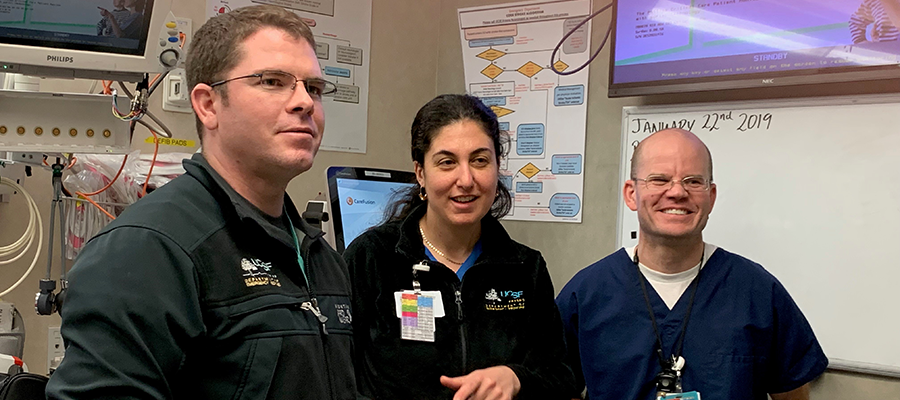Nicklaus Bradehoff, MD, Patil Armenian, MD, and Michael Darracq, MD
Emergency responders were told the three young men had snorted cocaine, but Nicklaus Brandehoff, MD, a UCSF Fresno toxicologist, had doubts. The patients’ repeated pinpoint pupils and depressed breathing despite treatment made him suspect a synthetic opioid, like fentanyl.
The next day, toxicologist Patil Armenian, MD, research director and associate professor of clinical emergency medicine at UCSF Fresno, ordered blood and urine tests sent overnight for rapid screening to a University of California, San Francisco (UCSF) affiliated hospital. The test results confirmed her suspicion: The men snorted fentanyl, a powerful synthetic opioid that is 50 times more powerful than heroin.
The quick laboratory confirmation made it clear that Fresno had not escaped the opioid that has killed people in epidemic numbers in other states. A news conference to alert the public of the drug’s presence in the community soon followed in which Dr. Armenian participated.
“Hopefully with all the warnings that went out, maybe we saved a life,” Dr. Armenian said.
Being able to identify the ill effects of an illicit street drug is part of the job for the toxicology team of Drs. Armenian, Brandehoff and Michael Darracq, MD, who see patients at CRMC. The toxicology team is a division of the UCSF Fresno Department of Emergency Medicine and the physicians are board certified in emergency medicine and toxicology.
The inpatient toxicology team is among a handful in California. Most hospitals rely on calls to poison control centers but the UCSF Fresno/CRMC bedside toxicology service provides a higher level of care. And toxicology teams have proven benefits for patients and hospitals, Dr. Darracq said. Data show that care by inpatient hospital toxicologists results in shorter patient stays and less testing, he said.
The toxicologists, who describe themselves as “medical detectives,” spend much of their time piecing together medical puzzles. In about 60 percent of the ingestion cases, toxicologists never know the specific agents the patients took but by knowing the signs and symptoms of toxicity (toxidrome) they can point to a class of medications and suggest an appropriate treatment, said Dr. Darracq, an associate professor of clinical emergency medicine at UCSF Fresno. “One of the things I emphasize with our residents is that toxicology is very physiology based. It’s understanding mechanisms and understanding general trends and themes.”
Many poisonings they see are of young children, especially toddlers. CRMC has a pediatric intensive care unit, and with the inpatient toxicology team “we really are the highest level of care for a poisoned pediatric patient,” Dr. Armenian said.
Poisonings of adults often are from exposures to a chemical in the workplace or the home, Dr. Armenian said. And overdoses (both intentional and accidental) are all too common.
Toxicologists treat every type of patient but they have special interests. Dr. Brandehoff, a health sciences assistant clinical professor of emergency medicine at UCSF Fresno, has an interest in herpetology and he helped develop snakebite protocols for the Fresno Chaffee Zoo.
With the nearby foothills home to Northern Pacific rattlesnakes, the toxicology team is an important asset for the community. “There’s a lot of nuances to treating a snake bite,” Dr. Brandehoff said. “If not treated correctly, there can be lifelong complications.”
There’s no predicting the poison, drug, snake or animal bite the toxicologists will confront and the job keeps them constantly reading and studying. But there’s a consensus on its rewards, as Dr. Darracq voiced: “It’s very satisfying where you make that diagnosis and you direct the providers in the right direction and a life is saved.”
